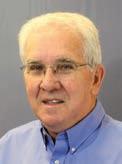RESOURCE
EQUIPPING CHURCH LEADERS EVENTS & SERVICES
MAY – AUGUST
REIMAGINE MINISTRY
God has plans for struggling churches
SUMMER 2019
ILLINOIS BAPTIST STATE ASSOCIATION
What really drives reliable leadership Neighborhood numbers can help renewal

Interactive pages for summer and back-to-school planning
Disney wisdom & dinosaur eggs
+
Dive into Summer 2 themes 2 locations 8 opportunities

Kids “Splash” Camps:

Week 1 – June 17-21 Streator
Week 2 – June 10-14 Streator

Week 3 – June 16-20 Sallateeska
Week 4 – June 24-28 Sallateeska
Week 5 – July 8-12 Streator
Week 6 – July 15-19 Streator
Student “Battle Ready” Camps:

Week 1 – June 24-28
Week 2 – July 15-19
(Lake Sallateeska and Streator)

IBSA.org/Kids To register go to
IBSA.org/Students (217) 391-3124 MarkEmerson@IBSA.org Help students in your church’s youth group develop as Christian leaders. (217) 391-3135 • JackLucas@IBSA.org Cost: $235 per student
INSIDE
SUMMER 2019
2 Eric Reed Advice from Uncle Walt and Grandfather Nehemiah
6 Jack Lucas
Your kids’ most important partnership
7 Mark Emerson Turning
8 Carmen Halsey
ILLINOIS BAPTIST STATE ASSOCIATION

EDITOR
Eric Reed
DESIGNER

Kris Kell
COMMUNICATIONS DIRECTOR
Lisa Misner
EDITORIAL CONTRIBUTORS
Meredith Flynn
Leah Honnen
MULTIMEDIA JOURNALIST
9 Dwayne Doyle
Andrew Woodrow
Published three times each year, Resource provides new information about IBSA ministries, equipping opportunities, and services. This periodical is sent free of charge to church leaders. To request more copies for your leaders, contact Communications@IBSA.org. Resource is also available online at http://resource. IBSA.org.
For questions about subscriptions, articles, or events contact the IBSA Communications team at (217) 391-3119 or e-mail: Communications@IBSA.org.
POSTMASTER: Resource is owned and published 3 times each year (Jan., May, and Sept.) by the Illinois Baptist State Association, 3085 Stevenson Drive, Springfield, Illinois 62703-4440.
IBSA.org 01 10 RENEW Mark Clifton’s guidance for breathing life into the church 13 PR OCESS OVER PERSONALITY Systematic planning propels your ministry Plus: An easy flow chart for drafting those systems 16 DINOSA UR EGGS Interactive: What could hatch and eat your best work 17 NEIGHBORHOOD SURVEY Demographics can define the church of the future INSIGHT
bench warmers into winners
Leaders learn to watch where they step
will
shoes? PLANNER
Calendars & events May through August 20 Interactive: Outreach for kids & communities 23 Preparing for back-to-school EQUIPPING 27 Leaders, missions, kids, services 32 Life cycle of the church
As the songwriter asked, Who
fill their
19
LEADER LIFE
Start small
Imagineering

“Will they revive the stones…?”
“It’s amazing how quickly human beings— and churches—lose their sense of purpose and vision,” Rick Warren writes. “Vision casting is not a task you do once and then forget about. You must continually clarify and communicate the vision of your church. This is the number one responsibility of leadership.”
Warren said leaders should communicate the vision of the church every 30 days. He points to an Old Testament example: When the Hebrews returning to Jerusalem were rebuilding the wall, they got discouraged about half-way through the 52-day process. The prophet exhorted them to redouble their efforts to finish the job.
Keeping people committed to what may be a long process is not easy. Read Neh. 4 and discuss with the team:
1. How is my church in its “small beginnings” stage?
2. What seems to be taking too long to complete, by my standards?
3. What does God have to say about my attitude toward smallness?
With all the talk today of revitaliza tion, the big question becomes How? And if we deduce the answer to that one, how do we bring others onboard?
Here are some ideas from an ancient prophet, Walt Disney. In the decades after Disney’s death, his team members expanded his kingdom based on his creative ethos. For more than 50 years, they have succeeded in keeping a herd of creative cats moving in one cohesive direction.
A Disney-coined phrase combines imagination with engineering. Leaders might also use these recommendations for “imagineering” as we develop and communicate the vision.
Imagineering VP Mickey Steinberg offered Mickey’s Ten Commandments to his team. For church leaders, start with the sanctified imagination of the Holy Spirit to develop and promote engaging and effective plans for ministry.
1. Know your audience
2. Wear your guest’s shoes. Don’t forget the human factors, see it from their point of view
3. Organize the flow of people and ideas. Ensure experiences tell a story that is organized and logically laid out.
4. Create a “wienie.” This was Walt Disney’s term for a “visual magnet,” something that catches both the eye and the imagination.
5. Communicate with visual literacy. Use a dominant color or shape or building to reinforce a theme.
6. Avoid overload. Do not offer too much detailed information.
7. Tell one story at a time. Put one “big idea” in each show.
8. Avoid irrelevant or contradicting elements. Make sure the audience has a clear idea of what is being said.
9. For every ounce of treatment, provide a ton of treat
10. Keep it up. Do not become complacent or allow things to run down. Effective revitalizers use imagineering to grow a creative team, and constantly sharing the vision to keep them engaged and excited to see the dream fulfilled.
Eric Reed, Editor
02 RESOURCE SUMMER 2019
Read Nehemiah 4
Revitalizing leaders tell the old, old story in a new, new way.
Executive

Church Cooperation Team






Church Communication Team









IBSA IBSA.org 03
DIRECTORY
Director
391-3108 John
Church
391-3110
Team Nate Adams Executive
(217)
Carruthers
Relationships Manager (217)
Jeff Deasy Associate Executive Director (217) 391-3104 Carole
Information Specialist (217) 391-3113 Drew
Director Information Systems (217) 391-3112 Kendra Jackson Bookkeeper (217) 391-3111 Ashley
Accountant (217) 391-3106
Doom
Heironimus
Parsons
Eric
Director; Editor, Illinois Baptist (217) 391-3109 Leah
Assistant (217) 391-3127 Kris
(217) 391-3115 Lisa
Director Communications (217) 391-3119 Andrew
Multimedia Journalist (217) 391-3117 Evangelism Team Pat
Associate Executive Director (217) 391-3129 Linda
Ministry Assistant (217) 391-3137
(217) 391-3120 Barb
(217) 391-3107
Reed Associate Executive
Honnen Ministry
Kell Graphic Artist
Misner
Woodrow
Pajak
Darden
Meredith Flynn Managing Editor Illinois Baptist
Troeger Executive Administrative Assistant
Church Resources Team
(217) 391-3136
Men’s Ministry and Missions Mobilization (217) 391-3134
Lake Sallateeska Baptist Camp (618) 336-5272
Women’s Ministry and Church Missions (217) 391-3143

(217) 391-3132
(217) 391-3135
(815) 672-0084
Zone Consultants
391-3126
391-3128
754-0356
Cliff
Zone 6 (618) 946-5720
Bob Evaul Zone 7 (618) 567-6170

Larry Rhodes Zone 8 (618) 972-5683










Ben Jones Zone 9 (618) 308-7600

Stephen Williams Zone 10 (618) 920-8545






04 RESOURCE SUMMER 2019
DIRECTORY
Mark Emerson Associate Executive Director Zone Consultant - 1 & 3
Dwayne Doyle Director
Philip Hall Manager
Carmen Halsey Director
Steve Hamrick Director Worship and Technology
Jack Lucas Director Student/Next Gen Ministries
Mike Young Manager Streator Baptist Camp
Tammy Butler Ministry Assistant (217) 391-3124
Debbie Muller Ministry Assistant (217)
Tammy Ratsch Ministry Assistant (217)
Joe Oliver Zone 2 (847)
Brian McWethy Zone 4 (815) 901-2767
Joe Gardner Zone 5 (309) 369-1403
Woodman
Aubrey Krol Ministry Assistant (217) 391-3138
Church Planting Team
751-0695
221-4173
Local Associations
ANTIOCH (270) 816-5236
BAY CREEK (217) 779-7477
BIG SALINE (618) 252-1415
CENTRAL (217) 428-1730
CHICAGO METRO (773) 278-4400
CLEAR CREEK (618) 833-4481
EAST CENTRAL (217) 586-5599
FOX VALLEY (573) 579-8143
FRANKLIN (618) 439-3742



GATEWAY (618) 254-3953
GOSHEN TRAIL (618) 643-2937
GREATER WABASH (618) 847-3041
HEARTLAND NETWORK (217) 529-3429
KASKASKIA (618) 227-0001

LAKE COUNTY (847) 336-3960
LOUISVILLE (618) 283-0842
MACOUPIN (217) 854-8279
710-3106
697-1036
E-mail IBSA Staff


Type the first and last name (no spaces) @IBSA.org.
Example: LisaMisner@IBSA.org

IBSA Zones

METRO EAST (618) 624-4444
METRO PEORIA (309) 633-5440
NINE MILE (618) 357-5171
NORTH CENTRAL (815) 633-6323
OLNEY (618) 392-7001
PALESTINE (618) 569-3189
QUAD CITIES (309) 221-4143
REHOBOTH (618) 283-0842
SALEM SOUTH (618) 242-7862
SALINE (618) 252-1440
SANDY CREEK (217) 882-2231
SINNISSIPPI (815) 440-2894
THREE RIVERS (815) 725-7361
UNION (618) 524-9738
WEST CENTRAL (309) 351-5499
WESTFIELD (217) 895-5214
WILLIAMSON (618) 993-6069
IBSA.org 05 DIRECTORY
Tim Bailey Suburban Church Planting Catalyst Northeast Region (814)
Jorge Melendez Strategist Fox Valley, Lake County (630)
Eddie Pullen Church Planting Director (618)
Ken Wilson Catalyst Central & Southern Regions (618)
John Yi 2nd Gen. Church Planting Catalyst Northeast Region (312) 608-0349
Rachel Carter Ministry Assistant (217) 391-3101
The parent/leader partnership
Get the role models on the same page
Iwas new to student ministry when my father-in-law asked a question that has since shaped my approach.

As the pastor of the church where I was serving as youth minister, he had watched me for a while before he asked, “Why don’t I ever see you interacting with parents?”
The answer was simple, to me. I had been hired to work with students. But he saw what I didn’t yet: Even before the role of family pastor became something we hear more often, a youth minister’s job was (and is) to minister to families—students and their parents.
For me, the answer was church softball. Playing on a team with the dads of my students opened doors for me to build relationships with whole families. That led to football-watching parties at our tiny, crowded house. The dads brought their kids to watch the game, and the moms played cards.
Those noisy nights created a dynamic in our youth ministry where parents bought in to what we were trying to accomplish with and for their students. The partnerships we built were especially helpful when kids struggled with big decisions or big mistakes. And the same is true today—especially as students face increasingly complex questions about gender identity, relationships, and living out their faith in a post-Christian culture.
Resources I recommend:
Foundations Bible study materials for teens and adults
By Robby and Kandi Gallaty
(LifeWay Press, 2015)
Meet Generation Z
By James Emery White
(Baker Books, 2017)
Look for opportunities to connect with parents apart from how they might volunteer in your ministry. Welcome them as chaperones, of course, but also communicate to them you want to partner with them in discipling their children.
The partnership may often feel one-sided, since student ministers are armed with resources and training on specific issues that parents may not have. But seize that opportunity: Put resources into parents’ hands and encourage them to be the main godly influences in their children’s lives.
Parents are facing an uphill climb, and it’s steep. They have increasingly less time to educate their children on difficult topics before someone else does. That’s where you come in: Recommend helpful books and voices who can speak biblically correct, theologically accurate advice into the lives of parents who are struggling to answer really hard questions.
Be there when they need you. I remember a call in the middle of the night from a student who had made a poor decision and was struggling with the fallout. I talked to him, and then his parents got on the line.
Building relationships with the whole family is work. It requires sacrifice on the part of the student minister and the parents, and both sides have to give time and energy to the process. There also will likely be differences of personality and generation to overcome, or at least areas where compromise is needed. Be intentional about ministering to parents and kids, and watch how God works in families.
06 RESOURCE SUMMER 2019
INSIGHT STUDENT MINISTRY
JACK LUCAS is IBSA’s director of student and next gen ministries for the Church Resources Team. JackLucas@IBSA.org
Surprise winners
Learn to see the potential in the leaders around you
Scott Hatteberg was a broken-down former catcher when baseball manager Billy Beane decided to recruit him for his Oakland Athletics. Hatteberg had injured his throwing arm the previous season, ending his career as a catcher. But what caught Beane’s attention (and captivated viewers of the 2011 movie “Moneyball”), was the potential he believed Hatteberg still possessed.
Beane knew Hatteberg had a rather large on-base percentage, and his injury didn’t affect his batting. The manager wanted to recruit and repurpose this broken player in order to capitalize on the strength he had left. (For those who may have not viewed the scene, search YouTube for Hatteberg and Moneyball and relive the moment with me.)
There are two leadership lessons I take from this example that may apply to your ministry context. First, if we’re going to win, we will need to identify the potential in players who may be hurt or broken, and help them find their place in the game. Take a look at Jesus’ bench in the Gospels and you will see plenty of folks who were on the disabled list, yet Jesus saw and seized their potential.
This kind of work takes a patient and intentional leader. Are there people in your church that would blossom if you believed in them and worked closely with them this year? Are there folks who may have stumbled in the past but with your help could get off the bench and back in the game?
Second, developing a broken player isn’t necessarily for the benefit of the organization as much as it is for the person. As a pastor, I made this mistake too many times. Too often we look at people for what they can do for us, instead of the greater purpose of developing them so they can live out their full potential in Christ. Think about it this way: Churches certainly benefit when leaders are developed, but the process is more more people-focused than organization-focused.
Let’s go back to our movie example. The broken catcher accepted the opportunity to save his career, and as it turned out, he also helped save his team. During the season that followed, Hatteberg found himself up to bat in the ninth inning of a crucial game. The A’s had won 19 games in a row, tying the American League record. Hatteberg hit a walk off home run to seal the 20th win. Sometimes when you take a chance on developing broken players, everybody wins!
Most of us don’t have the luxury of coaching a cadre of leaders who are immediately ready for the A-team. Such is the plight of small market baseball teams and most Baptist churches. Yet, there is good news! With the right development, many coaches and pastors can field a winning team.
 By Dan Reiland
MARK EMERSON is IBSA’s associate executive director for the Church Resources Team. MarkEmerson@IBSA.org
By Dan Reiland
MARK EMERSON is IBSA’s associate executive director for the Church Resources Team. MarkEmerson@IBSA.org

IBSA.org 07
Resource I recommend: Amplified Leadership
(Charisma House, 2012) INSIGHT LEADERSHIP DEVELOPMENT
Knowing what’s missing
While visiting London, England for a mission trip, I had multiple opportunities to ride the city’s underground rail system – the Tube. There were so many signs and announcements telling riders to “Mind the gap” when my team and I crossed from the Tube’s station platform to the subway car.
Since I’ve returned home, I keep thinking about those words, “mind the gap,” and how they relate to leadership. Leadership is the intentional influence over people’s thoughts and behaviors moving them toward a common outcome. But is there a gap between knowing that we need to help people move toward a goal and actually getting there.
I think there is, and the gap of often within the leader’s own skill set.
The leadership gap is the space between knowing what you know and what you don’t know that’s needed to lead in a specific role of leadership.
What’s the best way to understand it? Think of it like you’re cooking at home and all of sudden you realize you don’t have one of the ingredients. We easily recognize an ingredient is missing when we have a recipe. But when it pertains to leadership, there’s isn’t always a list to work from, And we’re not acting smart by saying there’s not a gap. We’re living in a constantly changing world demanding changes in our skill set. There’s always going to be a gap for a leader.
A few leaders in the Bible who successfully navigated the gap were Moses, Joshua, and Joseph. Chitwood, the new president of the International Mission Board is a current day leader who understands the importance of
By John P. Kotter
managing the gap. He spoke at a recent WMU leadership meeting I attended in Birmingham. He shared that, compared to previous roles, he’s in a learning mode right now. He’s doing a lot of listening. Chitwood said, “I don’t have the answers. I do have the heart, I do have a calling.”
Think of where you’re standing right now and ask yourself, “Where is the gap? What is causing it? What might be missing?”
These are my best tips for managing the gap:

1. Seek God and be confident in your calling. We had an event over Christmas that I was stressing over. I told God if we don’t need be doing it let me know. I let God take over.
2. Don’t be afraid to say, “I don’t know, but I’m going to go find us an answer.” When you do that, you’re modeling gap management for another person.
3. Admit mistakes and take responsibility for them. Learn from the mistake and be willing to change direction if needed, before more resources are wasted (especially the most important resource—people).
4. Learn what level of honesty is required. Be a leader with integrity, but remember not everything gets shared on every stage. Know your audience; think beyond the moment; tell them what they need to know. Understand what you need to say when you need to say it.
If we mind our own gaps, we’re not as likely to get tripped up when we step across the threshold into leadership.
08 RESOURCE SUMMER 2019
INSIGHT WOMEN’S MINISTRY
Resource I recommend: A Sense of Urgency
Business Press, 2008)
(Harvard
CARMEN HALSEY is IBSA’s director of women’s ministry and church missions. CarmenHalsey@IBSA.org
You can lead in the present if you mind the gap
Train your successor
An ancient example is a warning for modern leaders
Recently, it seems more and more pastors are thinking about who will take over for them once they retire. Especially in larger churches, these succession plans are becoming commonplace as a way to chart a successful course for future ministry—even after a long-time leader departs.
Moses spent much time developing the leader who would follow him. After Moses died, Joshua took over, leading the people into the Promised Land and reinforcing their collective commitment to the God who delivered them. “The people worshiped the Lord throughout Joshua’s lifetime and during the lifetimes who outlived Joshua,” Judges 2:7 says.
But after Joshua died, “another generation rose up who did not know the Lord or the works he had done for Israel. The Israelites did what was evil in the Lord’s sight. They worshiped the Baals and abandoned the Lord, the God of their fathers, who had brought them out of Egypt” (Judges 2:10b-12a).
We know that Joshua was the one Moses developed to lead, but who was Joshua developing? We don’t know for sure if there was a succession plan in place for the next Hebrew leader, but we do see that leadership was not passed down from one generation. After Joshua died, it all went sideways. The people went their own way, abandoning the faith that had brought them out of captivity.
When we talk about discipling men toward deeper faith and engagement in ministry, we can think of it in terms of finding the Joshuas that are sitting in our pews every week. As a pastor, you’re not choosing a person who will succeed you as pastor, but you are in a position to multiply yourself in the men of your church by training those who will take on key leadership roles. These fellow leaders will guide disciples in your church to grow more passionate for God’s Word and his purpose for their lives.
At IBSA, we want to help pastors develop those leaders in their own churches, starting by casting a compelling vision they can connect with. We need to recognize that men can do more than park cars or hand out bulletins. We need them as Sunday school teachers, missions leaders, and evangelists in their workplaces.
“Advanced Men’s Ministry Training” is a new resource we’ve identified as helpful in the process of developing men to lead. The guide is designed to help men understand the “why” of ministry, and also how God has uniquely created and positioned them so that more people will have an opportunity to hear and respond to the gospel. They will learn who they are in the context of God’s plan.
The Church Resources Team offers monthly webinars on training men’s ministry leaders as well as local coaching for men’s ministry. For more information about resources and training opportunities, go to IBSA.org/ Men or contact us at (217) 391-3134.
As you develop men to lead ministries in your church, consider this: How are you investing in the plans that will keep those ministries vital, effective, and producing gospel fruit?

INSIGHT MEN’S MINISTRY
IBSA.org 09 DWAYNE DOYLE is IBSA’s director of men’s ministry and missions mobilization. DwayneDoyle@IBSA.org Visit IBSA.org/ResourceCenter: “Overcoming the Fear of Witnessing” “Spiritual Conversation Starters” “How to Witness to Anyone, Anywhere, Anytime”
RETHINK REIMAGINE

God can breathe new life into dying churches
by Kayla Rinker
REVITALIZATION 10 RESOURCE SUMMER 2019
ach year Mark Clifton’s wife sends him on a mission to find the elusive bag of Christmas lights so he can start decorating the exterior of the house—for the grandkids, of course.
“I find the right bag, pull them out, and they’re always a tangled mess,” said Clifton, senior director of replanting for the North American Mission Board. “So I sit down on the front porch with the tangled ball and spend four or five minutes working before I realize life is too short. That’s when I wise up and go to Home Depot’s Christmas aisle to find the exact same lights.
“It’s an easy $20 to spend because I know every one of them will work and I don’t have to mess with the old lights anymore.”
The feeling he gets with the knot of lights is the same feeling Clifton once had about the congregation he pastored, Wornall Road Baptist Church in Kansas City. When Clifton was called as pastor there in 2006, church attendance had dwindled to less than 20 mostly elderly people in a sanctuary that seated 610.
Wornall Road had experienced decades of thriving ministry but, like so many churches, it lost its passion for making disciples and began to focus its attention on the people who remained, instead of unreached people outside the church.
“Why was I worried about untangling these messes when I could easily go down the street and start a brand new church?” Clifton said. “We could probably reach people faster that way, too.”
But then God spoke to him clearly and pointedly.
“What about a dying church brings glory to God?” he said. “What about a dying church says, ‘Our God is great and his gospel is powerful?’
“When a church dies, it’s not just the church that’s at stake. His name is at stake.”
God has since transformed Wornall Road into a thriving, multi-generational neighborhood church. The old lights were untangled a little bit at a time and the result has been beautiful revitalization that has breathed new life into the church and the community.
The road to revitalization
Wornall Road isn’t alone in its need for revitalization. Clifton said more than 900 Southern Baptist churches close each year, and 65-75% of SBC churches are considered plateaued. At the Illinois Leadership Sum-
mit, a gathering of ministry leaders from across the state, Clifton shared nine steps for any church seeking to reclaim its mission:
1. Glorify God in everything. Make every decision about God’s glory (and not merely about keeping people from leaving). Church is more than just keeping people from missing hell. It’s about showing people the joy of glorifying God for all eternity. Revitalize God’s church for God’s glory. Period. When every decision—big or small—is made with God’s glory in mind, it’s a huge indicator of a healthy church.
2. Repent and commit to finding joy in the gospel alone. A revitalizing church must no longer find joy in nostalgia and the “glory days” of church as it once was; they must find it in Jesus. The risen Lord is among your church. Point the church to repentance and follow his plan, not yours. Joy is not found in numbers or reaching new people, but in the risen Lord. Never get over that fact.
3. Pray without ceasing. Satan never leaves easily from that over which he has dominion. There is true spiritual warfare happening in a church that is being reborn or revitalized. The battling church must be bathed in prayer to conquer the evil one and reclaim Christ’s church. Pastors and church leaders are especially vulnerable. Satan is out to steal God’s glory, and there is nothing more glorious than the resurrected body of Christ.
4. Love and shepherd remaining members. Don’t be more concerned and in love with the church you wish you had than with the church you have. Focus on the spiritual growth of the existing congregation.
5. Serve the unique community where the church is located. The community is not there for the church; the church is there to bless and serve the community. Stop resenting the community for not responding as they once did, and never value your preferences over the needs of the unreached.
Love your neighbors. Make decisions based first on glorifying God, then serving. Located by a high school? The church doesn’t need a program, it needs to be
IBSA.org 11
Continued on p. 12
E
broken and in love with those teenagers. Neighborhood restaurant nearby? Give them free advertising in your bulletin and eat there often. Things in the community should be noticeably better because you’re there.
6. Use resources generously. Redeem the building. Think outside the church walls. Does the local high school football team need someone to host Thursday night spaghetti dinners? Come on in. Would that unused room make a cool kids birthday party room for the community? Transform it. Repurpose and redeem. People born in the last 30 years tend to bring coffee everywhere they go. Let them. Never allow preferences to create barriers to people coming in.
7. Simplify the strategy. Church does not have to be complicated. As long as a church exemplifies God-centered worship, makes disciples by providing opportunities for spiritual and relational growth, and demonstrates local and global service as a lifestyle, it accomplishes Christ’s purpose for the church. A church should not value the process more than the outcome. It shouldn’t care more about the bylaws than it does the Bible. A church should stay on the balls of its feet ready to pivot, not dig in its heels.
8. Intentionally develop young men. Invest in men ages 18-35. Be available when they’re available because they are working and supporting their young families. Churches that die never passed on meaningful leadership to the next generation. The goal is to get young men to connect and make them disciples, and then teach them to make disciples. Their style of leadership might look different than past generations. Of course it will! There is joy in that, too.
9. Celebrate the legacy often. A church that transforms from dying to thriving is like a living sermon in its community. Celebrate that. Wornall Road grew from 18 people when Clifton arrived to about 120 when he left. And Clifton said many of the original members still attend.
“They are like heroes of the faith to the new people,” he said. “One of the original ladies passed away and several of the young men in the church were pall bearers at the funeral. What a testimony to her faithfulness! She was not alone at the end, and the legacy lives on.”
What really counts
Once his heart softened to focus his ministry on the spiritual growth of his existing congregation instead of their numerical growth, Clifton said God breathed his resurrection life into Wornall Road Baptist Church. Members began to turn from making decisions based on personal preferences and toward making decisions based on serving the neighborhood.

“No, it’s not as comfortable singing worship songs that you don’t know,” Clifton said. “But hey, if you hear a 27-year-old singing a song you aren’t familiar with about Jesus, and they are singing it with their whole heart and you can’t worship God in that—you’ve got a real problem.”
Revitalizing the church is not about doing whatever is necessary to fill seats every Sunday, but Clifton said it is about making disciples. It’s about making disciples of people who have attended faithfully for decades, and of new people who are still deciding if church is relevant in their lives.
Clifton said the funny thing about many Southern Baptist churches is that they have a habit of counting everything that’s going on in the church—attendance, giving, baptisms—except the one thing that matters: disciples.
“I’m not saying we shouldn’t count those other things,” he said. “But we’ve got to redefine success. Nowhere in Scripture did Jesus say, ‘How many are you running?’ Success is making disciples who make disciples, which results in real community change.”
REVITALIZATION 12 RESOURCE SUMMER 2019 R
Kayla Rinker is a freelance writer and pastor’s wife in Missouri.
Systematic leadership
Create a plan for meaningful, lasting ministry

here is a lack of fellowship and community within the church body. It doesn’t feel like family anymore.”
“No one will help. If only we could get a few more people to step up and teach Sunday school or volunteer in the nursery.”
“People come to church and sit in a pew, but they aren’t getting plugged in.”
These are just a few of the problems church leaders face every day. Identifying the problem is easy. Finding the solution is often more challenging.
“So what do we do instead?” asked Nate Adams, executive director of the Illinois Baptist State Associa-
tion. “We lament, we complain, we suffer through it, or we just consider it a lost cause and settle for the status quo.” But in the Bible, Adams said at the Illinois Leadership Summit, God often called weak leaders in times of need. He raised them up and empowered them to lead everyone—through a process.
Leading through a process (and not just personality) is highly beneficial in ministry, Adams said.
“We’ve all seen leaders that rise or fall based on their winsomeness or communication gifts, and all of us lead through our personalities to some degree,” he said. “But whatever your personality type, using lasting processes can help achieve deeper and more lasting results.” He
Continued on p. 15
IBSA.org 13
“T
Process mapping
Design a new strategy from start to finish
One way to envision a new process or tweak an existing one is process mapping. This simple diagram can help your team determine the steps in a process and how they’re connected, as well as who needs to be involved along the way.
1. Start with symbols. Use a few distinct shapes to designate different kinds of activities within the process. Here are five symbols commonly used in process mapping; go to https://creately.com/ blog/diagrams/processmapping-guide/ for more.
Represents a step/activity of a process
Represents a decision that has to be made
Represents the start and end of a process
Represents the connection between two steps and the direction of flow
Represents data or information that can be read by people
2. Determine start and end points. Then, define the process steps between them. Organize them chronologically and draw them horizontally.
3. Write down the details. List sub-steps or details under each main step in the process.



Use this space to map a process your church is currently using or considering.
Process name:
14 RESOURCE SUMMER 2019
– Creately Blog, creately.com
defined a process as a series of actions or steps taken in order to achieve a particular end.
The first step to benefiting from a systematic leadership approach is learning to recognize the difference between “people issues” and “process issues,” Adams said. For many church issues it might seem like people and their limitations are to blame, but the reality is that inadequate or even nonexistent processes are most likely the bigger problem.
“We misunderstand and we think it must be my fault or old Bill over there needs to change,” Adams said. “But it’s more likely that old Bill would be more effective if there was a process in place.” When the process problem is clear and the desired results are clear, it’s much easier to think through the series of actions or steps that will lead to the desired results.
Another key to benefiting from systematic leadership is for leaders to honestly assess their own wiring when it comes to personality leadership vs. process leadership.
Personality-based people are people-oriented; they see the big picture; they like to be liked; they prefer verbal communication and thrive on interpersonal interactions; and they have the natural ability to inspire and guide the team just by being their winsome selves.
Process people, on the other hand, are task-oriented. They love details and getting the job done, and they prefer written communication and documentation. They use facts and information to map out how the team can follow the plan.
“You may find a complicated process in place that needs to be simplified for someone who is more personality-based,” Adams said. “I lean more process-driven, and I like to deliver information and establish credibility on every front. But that can get excessive if others are more relationship-minded and more verbal. You need to know where you land and get more of whatever you aren’t.”
Whatever a leader’s preference or bent, Adams said, he or she must remember to take into account that personalities can affect processes, and processes can affect personalities. A leader should understand both.
Designing the process
To start implementing systematic leadership practices, first identify the most persistent and hampering leadership challenges in the church. Many ministries can benefit from process leadership, including worship preparation, sermon preparation, outreach and evangelism, assimilation, fellowship, discipleship, missions, prayer, financial management, and stewardship development.
“For example, I attended a church that felt like fellowship was lacking and people didn’t really know each other anymore,” Adams said. “So they implemented a ‘Supper Six’ process where three couples would get together at each others’ houses for dinner once a month. They’d do it with the same people for a few months, and then pick out new names for the next round. Fellowship improved dramatically.”
Consider this process approach to outreach and evangelism: Instead of “we need to share the gospel more,” one church implemented a 5-5-5 process. Church members were asked to consider five networks they were in (for example, workplace, ball team parents, neighborhood, etc.), then pray for five people in each network, and think of five things or tasks that would invite those people to get closer to God.
“Process leadership is how we pursue helping people do what we hope they will do,” Adams said. “That kind of personal exhortation helps people see how their one decision to be part of the process allows them to be part of the forward momentum of the church as a whole.”
When it’s time to create the process, Adams suggests mapping out all the elements of the challenge as a pathway, with steps that include an honest beginning point and a clear, desired outcome. If a current process is already in place, determine whether it needs improvement or whether a new process is needed.
“Adding personality leadership into process leadership is when real influence takes place,” Adams said. “Giving developing leaders and disciples the tools of the process is when the whole thing starts to grow underneath you. Having clarity in purpose and clearly laid-out mission steps through processes can be transformative in your church.”
– Kayla Rinker
IBSA.org 15
R
from p. 13
Continued
INTERACTIVE PRE-PROBLEM SOLVING DINOSAUR EGGS
One leadership team added this step to its execution plan: Identify “dinosaur eggs.” Those were problems that might hatch during implementation and sink their teeth into the project. Sort of like the SWOT analysis, naming “eggs” prompts the team to address problems before they arise. The size and type of “eggs” depends on the size and nature of the project. Here are a few categories that may need special attention.

• Vision
• People
• Opinions
• Enthusiasm
• Resources
• Finances
• Communication
• Timetable
Think of a project or change your church wants to implement. Identify four broad categories from the list where you see potential problems. Label each egg with one category. Then inside each egg, list 2-3 specific issues related to that category that your team can address (or at least prepare for) before they hatch. Remember, not all the eggs will hatch, but you can be ready!
16 RESOURCE SUMMER 2019
Revitalization by the numbers
What neighborhood demographics can tell you about rebuilding the church

Have you ever heard yourself saying something like this? “Times are changing too fast and I wish they would just slow down.” Or, “I wish everything could go back to the good ol’ days.” Or, “I am staying the way I am.”
These statements may be true for a variety of things in our lives, but these are death sentences for churches, according to Mark Clifton, senior director of replanting at the North American Mission Board. People making these comments are often signaling a disconnect from a changing world, the very world we are called to reach with the gospel.
If you’re hearing such comments among your church members, it’s time to explore revitalization. And a good place to start is with examination of the neighborhood. The numbers will tell a lot about the church and the change it faces.
So how do demographic studies help in revitalization? Data validates the rate of growth or decline and can forecast accurately the trend lines to be expected in the future. Demographics help identify the true make-up of the church’s community to help understand the changes. Here are three steps to take when considering church revitalization or wondering if you are at that step.
Pray. When was the last time the church cried out to God to reach the community, not just to bring more people to help pay the bills? The first step is to pray for God to open doors for the church to share the gospel in a real and effective way, and for God to reveal himself and his vision for his church.
Assess the trends. Through the Annual Church Profile collected by IBSA, church leaders can look at
Continued on p. 18
IBSA.org 17
data from the past 20 years and forecast what the next several years are going to look like. Just by looking at the numbers, you will be able to identify changes in leadership and significant positive or negative events within the church. From these data points, you will be able to understand where the church has been, which indicates where it can go. You will also be able to identify what the future looks like by forecasting data.
Understand the neighborhood. What does the neighborhood look like? Not just the people, but have the neighborhood dynamics shifted in such a way that the church no longer mirrors its surroundings?
Through a partnership with Mapping Center for Evangelism, IBSA can identify key information about individual neighborhoods, such as average age, length of residence, marital status, income level, culture worldview, ethnicity, and more. As Clifton points out, dying churches have two things in common: They have lost their identity in the neighborhood, and they no longer look like the community.
“If your church closed its doors for good, would anyone outside of the church know or care?” This is a question Clifton asks churches seeking revitalization. While this a hard question, it is one that needs to be asked.
If a church is truly invested and making an impact in its community, that church will reflect the neighborhood. Other questions that should be asked: How many people do we know from the community well enough to pray for them right now? Do these people know we are praying for them and on their behalf? Are we actively ministering in the simplest form of ministry for our surrounding community, prayer?
IBSA zone consultants can help you obtain and understand your church’s demographics. Along with prayer, that’s a great first step toward revitalization.
What time is it? A simple self-test
It is it time to revitalize? Or maybe it’s time to consider starting over by replanting in the same location. NAMB offers a Church Health Assessment with these simple “True/False” questions. Circle your responses.
Our church seeks to reach the local community via programs and/or events.
Our church has grown frustrated with the lack of response from the community.
Our church has experienced an attendance decline for more than three years.
The way our church makes decisions—according to policies and procedures—is valued more highly than the end results of the decisions.
Our church makes taking care of the needs of those present in the congregation a high priority, perhaps more than focusing on the needs of those who might come from outside.
Our church struggles to find and then develop leaders, especially those in younger generations.
I feel like our church has become detached from our community.
I fear that no one would miss our church if we closed the doors.
Many in our congregation live more than a 5-minute drive from our physical location.
Our church attendance may have declined but our activity level and ministries have not.
We take a lot of pride in our facilities and put a lot of energy into caring for them.
Our church is struggling to pay bills in a timely manner.
Our church has been unable to pay the pastor in an appropriate manner.
We are unable to attract young people and young families to become committed members in the life of our church.
JohnCarruthers@IBSA.org

If the church trends continue in both attendance and giving, I fear our church will close in the next five years.
If more than three answers are true, then your church may be in danger of closure or is a candidate for replanting.
18 RESOURCE SUMMER 2019
T F T F T F T F T F T F T F T F T F T F T F T F T F T F T F
JOHN CARRUTHERS is IBSA’s church relationships manager.
2019
Calendar Highlights

IBSA.org 19
SUMMER
PLANNER
A few dates and events that may affect our ministry plans
4-5 All-State Choir Retreat 18 Illinois Baptist Women University 19-26 Associational Mission Emphasis
1 Missions Spectacular 11-12 SBC Annual Meeting 23 Mission: Dignity Sunday 25-28 Super Summer
8-12 Summer Worship University 13-20 Illinois Changers (Peoria)
9-10 Illinois Baptist Men Equip Weekend 18-24 Worship Music Week 29 iConnect
MAY
JUNE
JULY
AUGUST
Kids
INTERACTIVE SUMMER OUTREACH IDEAS Community
Protecting the screen-gen
How do you keep kids safe on social media? The church can help. Offer practical training to parents on understanding the ever-changing world of social media. One option is to have the local police chief come and speak to the dangers of living in a world where our kids are constantly online. FBC Bethalto recently hosted Brian Housman of 360 Family, author of Tech Savvy Parenting. He shared several sessions with parents and students on avoiding the traps of social media. Your church can do something similar and open it up to the entire community.
Before school’s out
Teachers often get thank you gifts, but what about the bus drivers? Put together some type of care package for the bus drivers of your school. Let them know how much you appreciate the important (but often thankless) job they do. Also, let them know you will be praying for them as they drive the bus each day.
– from Metrolina Baptist Association
It’s all about the essay
Provide college-application assistance. Outreach magazine says an effective ministry to high schoolers (and their parents) is helping them get into college. Host workshops to assist juniors and seniors with their college applications, including essays. We would add that some kids need insight when deciding on an education pathway. Invite Christian college representatives or alumni from your church to meet with upcoming graduates one-on-one for some encouragement.
Nursing home chorus club
The little stars in children’s ministry don’t mind singing a few tunes for the folks at the nursing home. Once a year, sometimes twice, says Children’s Ministry Matters, book an hour to sing in the senior center or assisted living complex. This audience will love hymns and pretty soon will everyone be singing along.
On the sunny side

Have you ever left home for a sporting event only to forget your sunglasses? A Cincinnati church told Sermon Central they show up at sporting events with boxes of shades. Many attendees are grateful the don’t have to hold a hand up to shield their eyes for several hours. You can purchase large quantities of sunglasses for as little as a quarter a pair.
Make yourself at home
Create a newcomer’s group in your neighborhood to help welcome new families, says the Prepscholar blog. Or do the tried and true welcome wagon. Find out from the Chamber of Commerce or postal service which addresses have new residents. Then deliver welcome baskets to people who move into your community. Include baked goods or pantry items, information about your church, as well as coupons to local businesses.

Singles dream team
About one-third of adults in any community are single. Facts & Trends magazine advises form a top-notch team to pray and plan multiple small groups, events, and ministries for singles. Kick off with a single adult retreat and ask church members to invite their friends.
Election day

One church reported to Facts & Trends during the week before a local election, they had each Bible study class select one position such as sheriff or city commissioner. The group purchased a Bible, highlighted favorite Scriptures, and delivered it to the winner immediately after the election. They included a note promising prayer for that
“First of all, then, I urge that supplications, prayers, intercessions, and thanksgivings be made for all people, for kings and all who are in high positions, that we may lead a peaceful and quiet life, godly and dignified in every way.”
– 1 Timothy 2:1-2
20 RESOURCE SUMMER 2019 PLANNER
MAY
3-4 Disaster Relief Blue Hat Training
First Baptist, Manteno
3-4 Northern Disaster Relief Training
First Baptist, Manteno
4-5 All-State Choir Retreat Location TBA
5 Senior Adult Sunday
12 Mother’s Day
1 2-18 Christian Home Week
18 IL Baptist Women University IBSA Building, Springfield
19-26 Associational Mission Emphasis
27 Memorial Day - IBSA Holiday
NOTES:
PLAN AHEAD FOR Gardening as Missions

Call all the gardeners together and ask, “How can we turn our hobby into a mission project or evangelistic outreach?”
Organizer: Gardeners:
Target group:
Market dates:
21 PLANNER
IBSA.org
JUNE
1 Missions Spectacular Multiple Locations
8 CrossOver Birmingham, AL
10-11 SBC Pastor’s Conference
Birmingham, AL
10-14 Week 2 - Kids Splash Camp
Streator Baptist Camp
11-12 SBC Annual Meeting
Birmingham, AL
14-15 Father/Son Camp
Lake Sallateeska & Streator Baptist Camps
16 Father’s Day
16 Baptist Men’s Emphasis
16-20 Week 3 - Kids Splash Camp
Lake Sallateeska, Pinckneyville
17-21 Week 1 - Kids and Student Splash Camp
Streator Baptist Camp
23 Mission: Dignity Sunday
24-28 Week 4 - Kids Splash Camp Camp
Lake Sallateeska, Pinckneyville
24-28 Week 1 - Student Battle Ready Camp
Lake Sallateeska, Pinckneyville
25-28 Super Summer
Greenville University, Greenville
30 Citizenship and Religious Liberty Sunday
PLAN AHEAD FOR
Back-to-School Season
Yes, it feels early, but now is the time to plan new discipleship opportunities that will start about the same time as the new academic year. List three interests, age groups, or life stages that need a cohort, such as
Newly or nearly married
Single again
English as a second language
Going deeper Bible study
Make your own topic or group list here:
Possible teachers or leaders:
Available meeting locations:
Start Date:
NOTES:
22 RESOURCE SUMMER 2019 PLANNER
IBSA.org 23 PLANNER
24 RESOURCE SUMMER 2019 PLANNER
JULY
4 Independence Day - IBSA Holiday
8-12 Week 5 Kids and Student Splash Camp
Metro Peoria Streator Baptist Camp
8-12 Summer Worship University Camp
Hannibal-La Grange University, MO
13-19 All State Choir Mission Tour
New Orleans
13-20 IL Changers Peoria Project
14-19 Week 2 - Student Battle Ready Camp
Lake Sallateeska, Pinckneyville
20 BCHFS Board Meeting
Carmi
NOTES:
PLAN AHEAD FOR
Outdoor baptisms

Those photos we see of baptism at the River Jordan, or Lake Michigan, or what one southern Illinois church calls “the hippie hole” remind us that the water is warm enough to take the sacred ceremony outside where it originated. Pick a pond or a pool and start dunking. For someone, that will be a very special memory.
Organizers:
Location:
Baptism candidates:
Dates:
IBSA.org 25
AUGUST
2-3 IL Baptist Women University

IBSA Building, Springfield
4 Social Issues Sunday
5-6 Associational Roundtable
IBSA Building, Springfield
9-10 IL Baptist Men Equip Weekend Location TBA
11 Student Evangelism Day
12 Strategic Planning Committee Meeting
IBSA Building, Springfield
12 Administrative Committee Meeting
IBSA Building, Springfield
13 Resource Development Committee Meeting
IBSA Building, Springfield
15 IBW Coaching Workshop A
IBSA Building, Springfield
17 IBW Coaching Workshop B
IBSA Building, Springfield
18-24 Worship Music Week
19 Nominating Committee Meeting
IBSA Building, Springfield
20 Committees on Committees Meeting
IBSA Building, Springfield
29 iConnect IBSA Building, Springfield
PLAN AHEAD FOR
Offering & Week of Prayer
Coming in September
Look for the promotion kit in the mail.
Meet with the missions team and worship leaders to plan promotion of the Week of Prayer and Offering season in September.
Plan a special emphasis for several worship services, using the study guide and videos in the kit.
Enlist enthusiastic people who have served on missions teams in Illinois, or leaders who have benefitted from IBSA equipping to tell the story of state missions.
Pray and give.
NOTES:
26 RESOURCE SUMMER 2019
EQUIPPING
IBSA Highlights
LEADERS
Illinois Leadership Summit
SBC Annual Meeting
6/11-12 Birmingham, AL
“Gospel Above All” from 1 Corinthians 15:3-4 is the theme for the SBC annual meeting. “It is the Gospel that is the source of our renewal, and it is the Gospel that should be our defining characteristic as a people,” said first-term SBC President JD Greear. “[The Gospel] should be what people think about and talk about when they think and talk about us.” Greear also stated the schedule will be tighter with no evening sessions at the meeting. The social media hashtag is #SBC19
Leading on Empty Church Technology Conference
MISSIONS
Children’s Missions Day

Disaster Relief training
KIDS & TEENS
IBSA Camps (see back cover) Super Summer
IBSA.org 27
SUMMER 2019
SBC.net
A time for leaders from across America to gather for the singular purpose of hearing God’s word preached from some of the most gifted preachers and leaders of our day.

Featured is Andrew Brunson, who served in Turkey 25 years in church planting, training, and refugee training before being falsely imprisoned by that country for terrorism and espionage.

SBCPC.net
Speakers include:
• Dhati Lewis, lead pastor of Blueprint Baptist Church in Atlanta and Vice President of SEND Network
• Ed Litton, pastor of Redemption Church in Mobile, AL
• Ben Mandrell, lead pastor of Storyline Fellowship, church plant in Denver

• Russell Moore, president of the Ethics & Religious Liberty Commission
• David Platt, pastor of McLean Church in Washington, DC
• Jimmy Scroggins, lead pastor of Family Church in South Florida
• Robert Smith Jr., professor of Beeson Divinity School
• Katherine and Jay Wolf, survivors and storytellers, advocates for the disabled
• Martin Young, senior minister of Rising Brook Community Church in Birmingham, UK
8/29 IBSA Building, Springfield
A perfect event for pastors and church staff who are new to Illinois, serving in a new ministry, or want to get better connected with IBSA and fellow Baptists in Illinois. Come away with a better understanding of who we are, what we do, and how we are committed to working together.
(217) 391-3138 | AubreyKrol@IBSA.org
28 RESOURCE SUMMER 2019
LEADERSHIP
Training Days and Nights
5/14 Northside Baptist, Dixon (Night)
8/13 First Baptist, Bethalto (Night)
8/24 Fairfield First Baptist (Day)
Training night is an opportunity for every church leader to receive quality instruction for ministry leadership. There will be an opportunity to attend two sessions on a variety of subjects, including XXXXXXX.
IBSA.org/TrainingDay
IBSA.org/TrainingNight
(217) 391-3124
MarkEmerson@IBSA.org
Coaching Workshop
8/15, 8/17 IBSA Building, Springfield
Coaching is a key leadership component in organization today. Participants will gain an increased awareness of the benefits of coaching and be introduced to coaching tools.

Cost: IBSA churches—$25, non-IBSA churches—$159
IBSA.org/Women
(217) 391-3128
TammyRatsch@IBSA.org
Disaster Relief Training, North
(Yellow shirts and blue hats)
5/3-4 First Baptist, Manteno
Disaster Relief Training Weekends involve a Friday evening and Saturday daytime schedule. The Chaplaincy class begins on Friday afternoon at 1 p.m. New volunteers should attend the Friday evening Introduction to Disaster Relief 101 Class and then take specialty classes on Saturday.


IBSA.org/DR
DwayneDoyle@IBSA.org
(217) 391-3134
IBSA.org 29 LEADERSHIP & MISSIONS
– Chainsaw team, Taylorville (2018)
Cost: $180 per person
IBSA.org/ILchangers | DwayneDoyle@IBSA.org | (217) 391-3134

6/1 Multiple locations
Illinois Baptist’s largest one-day annual mission project is Missions Spectacular. Choose from multiple ministry sites around the state, each with individual projects for your family or your church to participate.


IBSA.org/Spectacular | (217) 391-3134
7/13-19
university
An IBSA event @ Hannibal-LaGrange | July 8-12
Our premier worship, music, and arts event for students is Summer Worship University. For students completing grades 6-12, we offer over 30 classes choices covering subjects including piano, guitar, drums, art, movement, Bible studies, sharing your faith, band, voice, apologetics, and much more.
Cost: $225 per student
Choir and orchestra members are selected from students in grades 9-12, based on a strong Christian lifestyle, church attendance, the recommendation of their church’s pastor or music director, and successful completion of the musical audition. They will sing and minister in New Orleans. Choir members will attend Summer Worship University
7/8-12.
Approximate cost: $650 per student
Father/Son Overnight
6/14-15 Lake Sallateeska and Streator Baptist Camps

An overnight camp for fathers and sons of all ages. Many dads use this as a special time to connect with their younger sons. Don’t miss an awesome camping opportunity for fathers and sons, grandpas and grandsons, adult mentors and young men of all ages.
Cost: $40 per person

30 RESOURCE SUMMER 2019 KIDS & STUDENTS
DwayneDoyle@IBSA.org | (217)
IBSA.org/Kids
391-3134
IBSA.org/Students | (217) 391-3126 | DebbieMuller@IBSA.org
IBSA Camps

Lake Sallateeska
Our camp in southern Illinois just celebrated 75 years as Baptists’ favorite woodland getaway. The facilities set on beautiful Lake Sallateeska near Pinckneyville are home to summer camps for kids and teens, along with a variety of retreats and events for churches and their leaders all year long. Cabins can sleep up to 200, and the Sallateeska Inn, built in 2000, offers 16 rooms of hotel-style lodging. The camp is special to generations of Illinois Baptists as so many found Christ and their calling there.
Philip Hall, Manager
(618) 336-5272
LakeSallateeska@IBSA.org
IBSA.org/LakeSallateeska
Streator

Our camp in northern Illinois, Streator Baptist Camp and Retreat Center, is lively and bustling with activity. Two years of renovation led by camp manager Mike Young have produced a bright and cheerful place that’s perfect for kids’ camps and adults’ retreats. Its half-dozen buildings situated lakeside can accommodate meeting space for up to 200, and dining and lodging for 136. The 1.3-acre lake is a state-licensed swimming area with a 100-foot sand beach and a permanent dock. There are two pavilions for outdoor meetings and cookouts, and wonderful trails for hiking.
Mike Young, Manager (815) 672-0084




Streator@IBSA.org
IBSA.org/Streator
Baptist Foundation of Illinois

“There is something special about writing out our tithe check to the church every payday,” said a smiling Stephanie Grove, a member of First Baptist Church, Fairview Heights. She and her husband, David, are clients of the Baptist Foundation of Illinois.

“Estate planning that provides for Kingdom causes is rare for most Christians,” Stephanie shared. She urges people to think ahead of how they can keep giving after they have gone. “By delaying we are squandering the greatest giving opportunity we may ever have.”
BaptistFoundationIL.org

(217) 391-3116
BCHFS: 100 years of ministry
One hundred years ago three men in Carmi, Ill. were pioneers when they came together to found what became Baptist Children’s Home and Family Services.
“Our responsibility is no different than what these men and other Baptists did 100 years ago,” said Executive Director Denny Hydrick. “Though it is not a world war or a severe flu epidemic that creates a dire need in Illinois to care for children and families, today we are fighting a different war, one where the causalities are our families.”
Denny Hydrick
Administration Office
949 County Rd. 1300 N. Carmi, IL 62821 | (618) 382-4164
BCHFS.com
SERVICES & FACILITIES IBSA.org 31
Doug Morrow
Sheila Jessen
A SMALL LIST of small things
Facilities
Outreach
Discipling (Sunday school, small groups, men/women)
Kids and teens
Leadership
Community Outreach
Witness training/ evangelism
Missions
Worship
Welcoming guest and follow-up
32 RESOURCE SUMMER 2019
INTERACTIVE XXXXXXX

Illinois Baptist State Association

3085 Stevenson Drive Springfield, IL 62703
A one-day youth evangelism event offering great music with Christian artists and top speakers for teens.

For more information, go to IBSA.org/YE2019
AWSOM (*Amazing Women Serving Our Maker) is a conference for girls in grades 7-12 offering hands-on missions, worship, and missionary speakers. Focus on current social issues and see opportunities to engage their world with the gospel.

For more information and to register, visit
IBSA.org/AWSOM
IBSA Building, Springfield
NOV. 1- 2
DIRECTORY PLANNER EQUIPPING
IBSA people who can help For summer events & outreach ideas Training events & conferences Starts on page 3
Starts on page 19
Starts on page 27
Nonprofit Organization U.S. POSTAGE PAID
No.
Peoria, Illinois Permit
325
soon
Coming






















































 By Dan Reiland
MARK EMERSON is IBSA’s associate executive director for the Church Resources Team. MarkEmerson@IBSA.org
By Dan Reiland
MARK EMERSON is IBSA’s associate executive director for the Church Resources Team. MarkEmerson@IBSA.org








































